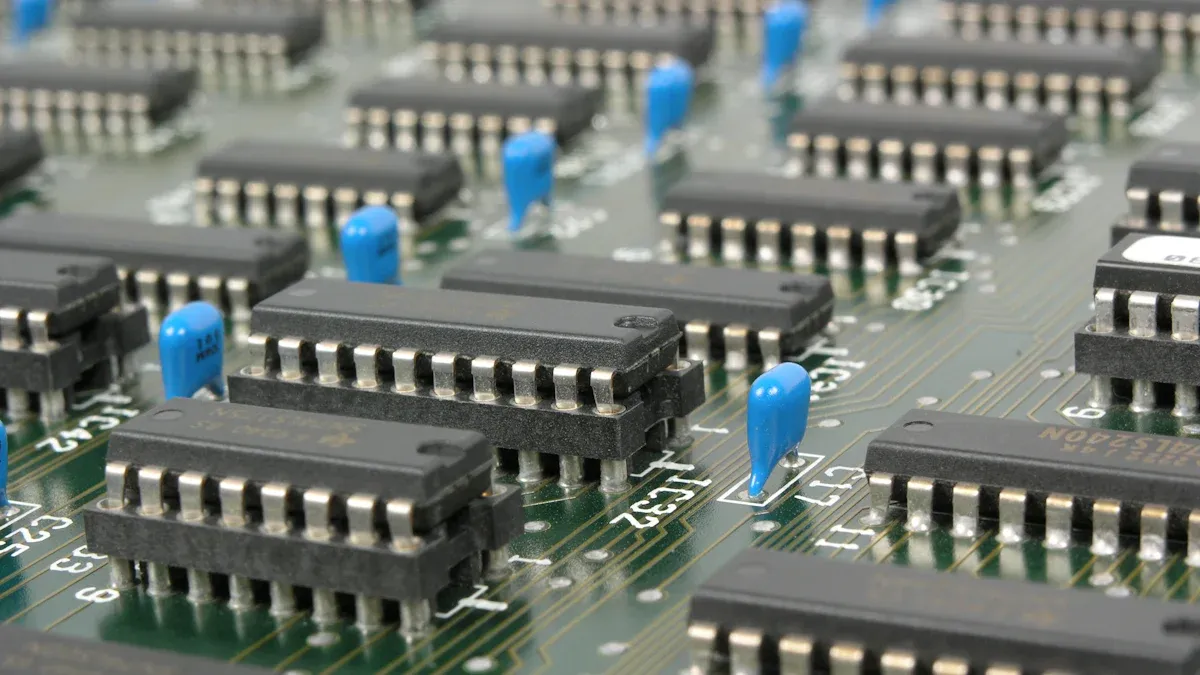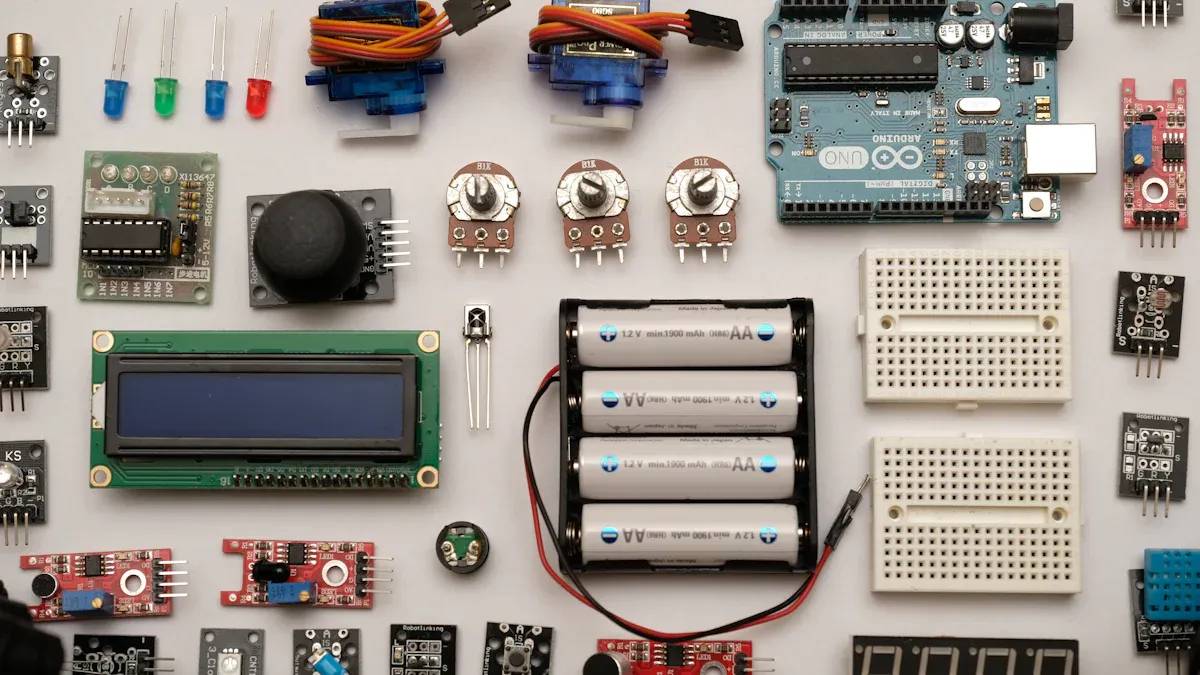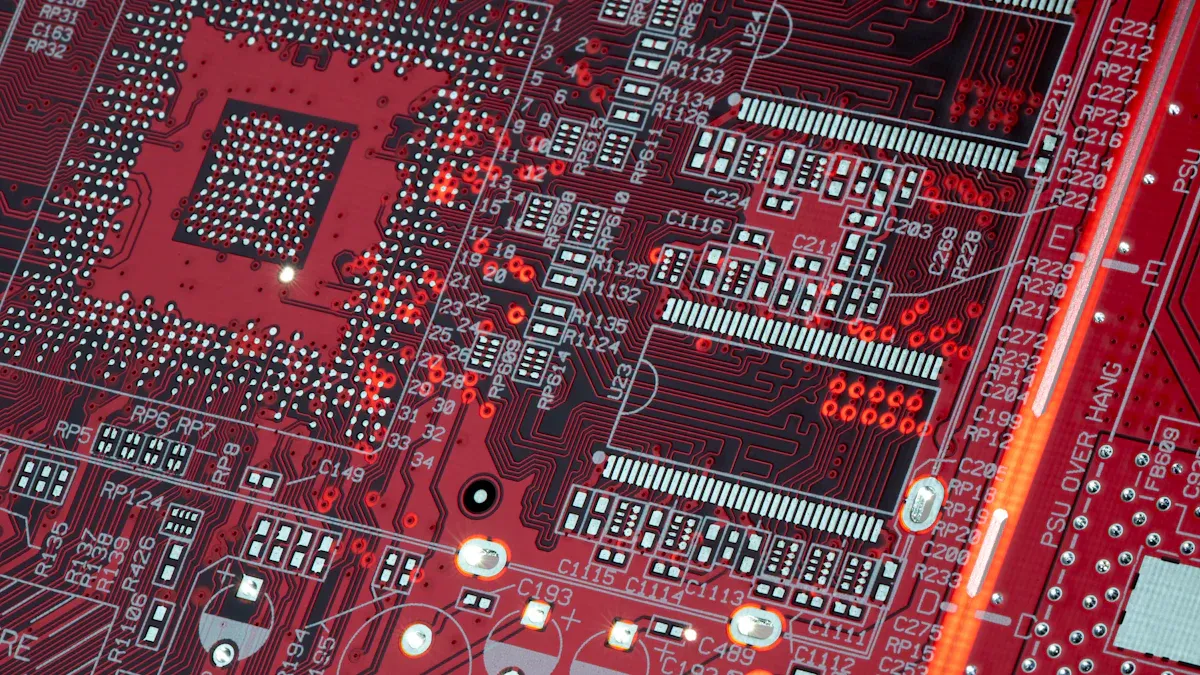SN74S174J vs Others: Which Flip-Flop Wins?

The SN74S174J works very well in fast digital circuits. It keeps timing accurate and protects data, making it great for speed-focused tasks. Its strong design can handle tough timing jobs. But, it may not fit every need. If saving power or money is more important, other options like the SN74LS174 or SN74HC174 might be better. Knowing these differences helps you pick the best flip-flop for your project.
Key Takeaways
The SN74S174J works well in fast digital systems. It switches in just 15 nanoseconds for low-to-high signals.
Its strong build lets it work in very hot or cold places. This makes it great for factories and military use.
If your project needs speed and accurate timing, pick the SN74S174J. It is faster than slower flip-flops.
The SN74S174J uses up to 692 milliwatts of power. This makes it less useful for low-power projects than the SN74HC174.
When choosing a flip-flop, think about what your project needs. Look at speed, power use, and cost.
The SN74LS174 and SN74HC174 are better for saving money or energy. They use less power than the SN74S174J.
Knowing what each flip-flop does well or poorly helps you choose wisely for your designs.
For projects needing perfect timing, the SN74S174J works reliably. It is a key part of fast systems.
Overview of SN74S174J
Key Specifications
The SN74S174J is a fast D-type flip-flop made for accuracy. It works well in digital circuits that need speed. Below are its main features:
Feature | Value |
|---|---|
Delay Time (Low to High) | |
Delay Time (High to Low) | 22.00 nanoseconds |
Power Dissipation Limit | 692.0 milliwatts |
Working Temperature Range | -55.0 to 125.0 °C |
Storage Temperature Range | -65.0 to 150.0 °C |
Voltage Limit | 5.5 volts maximum |
These values show it can handle fast tasks and tough conditions. Its quick delay time helps with fast data changes, which is key for timing-focused uses.
Strengths and Weaknesses
The SN74S174J has many good points. It performs very fast and is reliable. It keeps timing accurate and protects data in tough situations. Its wide temperature range makes it useful for industrial and military tools. The strong design also makes it last longer.
But there are some downsides. It uses a lot of power, up to 692 milliwatts. This makes it less useful for low-power projects. It can also cost more than other options like the SN74LS174 or SN74HC174, which are better for saving money.
Common Applications
The SN74S174J is used in many fast digital circuits. Some common uses include:
Timing-critical systems: Its quick delay time keeps timing accurate.
Data storage and transfer: It keeps data safe during fast operations.
Industrial and military tools: It works well in extreme temperatures.
Clock generation circuits: Its accuracy makes it great for clocking tasks.
If your project needs speed and dependability, this flip-flop is a great pick. But for saving power or money, other choices might be better.
Comparison Criteria
Speed
The SN74S174J is very fast. It has delay times of 15 nanoseconds for low-to-high and 22 nanoseconds for high-to-low transitions. This makes it one of the quickest flip-flops. Its speed helps keep timing accurate in circuits where every nanosecond matters. If your project needs to handle high-frequency signals or timing-critical tasks, this flip-flop works great. Other options like the SN74LS174 and SN74HC174 are slower. They are not as good for fast data processing.
Tip: Pick the SN74S174J for projects needing speed, like clock circuits or fast data transfers.
Power Consumption
Power use is important for battery-powered or energy-saving designs. The SN74S174J uses more power than other choices. Its maximum power dissipation is 692 milliwatts, which is higher than the SN74LS174 and SN74HC174. Here's a comparison:
Part Number | Maximum Power Dissipation Rating |
|---|---|
SN74S174J | 692.0 milliwatts |
This high power use makes it less ideal for low-power projects. If saving energy is key, the SN74LS174 is a better choice. It uses less power but still works reliably.
Note: The SN74S174J is fast, but its high power use may not fit energy-saving designs.
Reliability
The SN74S174J is very reliable. Its strong design and wide temperature range (-55°C to 125°C) make it great for tough conditions. It works well in industrial tools or military systems. It keeps working even in extreme environments. Other flip-flops like the SN74LS174 and SN74HC174 are also reliable. But they may not be as durable as the SN74S174J in harsh settings.
Callout: For projects in tough conditions, the SN74S174J is a solid and dependable option.
Application Suitability
Picking the right flip-flop depends on your project’s needs. Each flip-flop works best in certain situations. The SN74S174J is no different. Let’s see where it performs well and where other choices might work better.
High-Speed Circuits
For fast circuits, the SN74S174J is a great option. It switches quickly, taking only 15 nanoseconds for low-to-high changes. This makes it perfect for high-frequency tasks like clock circuits or fast data buses. These uses need exact timing, and the SN74S174J delivers reliable results. But if speed isn’t as important, slower options like the SN74LS174 save more power.
Tip: Choose the SN74S174J for tasks needing fast and precise timing.
Low-Power Designs
For projects needing less power, the SN74S174J might not be ideal. It uses up to 692 milliwatts, which can drain batteries fast. In these cases, the SN74HC174 is a better pick. It uses less energy, making it good for portable devices or energy-saving systems.
Note: Use low-power flip-flops for energy-saving designs, even if they’re slower.
General-Purpose Applications
For simple circuits, you may not need the speed of the SN74S174J. Everyday tasks like storing data or basic logic can use cheaper options. Flip-flops like the SN74LS174 or 74LS74 work well and cost less. They also use less power, making them good for non-critical jobs.
Timing-Critical Applications
Timing-focused systems benefit a lot from the SN74S174J. Its quick delay times and strong build ensure accurate timing. It’s great for industrial tools, military equipment, and places where timing errors can’t happen. It also works well in extreme temperatures, adding to its reliability.
Callout: For tasks needing perfect timing, the SN74S174J is a top choice.
By knowing your project’s needs, you can decide if the SN74S174J or another flip-flop is better. Fast and timing-critical tasks suit the SN74S174J, while low-power or simple jobs may need other options.
SN74S174J vs Popular Alternatives

SN74S174J vs SN74LS174
Speed Comparison
The SN74S174J is faster than the SN74LS174. It switches in 15 nanoseconds, while the SN74LS174 takes about 25 nanoseconds. This makes the SN74S174J better for fast circuits needing precise timing. The SN74LS174 works fine for slower tasks that don’t need quick switching.
Tip: Use the SN74S174J for high-speed signals or fast data tasks.
Power Consumption Comparison
The SN74S174J uses more power than the SN74LS174. It consumes up to 692 milliwatts, which isn’t ideal for saving energy. The SN74LS174 is made for low-power use and needs much less energy. This makes it better for battery-powered or energy-saving projects.
Reliability Comparison
Both are reliable but work best in different settings. The SN74S174J handles extreme temperatures (-55°C to 125°C), making it great for industrial or military uses. The SN74LS174 is reliable in normal conditions but not for harsh environments.
SN74S174J vs SN74HC174
Speed Comparison
The SN74S174J is quicker than the SN74HC174. It switches in 15 nanoseconds, while the SN74HC174 takes about 30 nanoseconds. This speed makes the SN74S174J perfect for timing-critical tasks.
Power Consumption Comparison
The SN74HC174 wins in power efficiency. It uses much less energy than the SN74S174J. If saving power is more important than speed, the SN74HC174 is the better choice.
Reliability Comparison
The SN74S174J is tougher in extreme conditions. Its strong design and wide temperature range make it better for harsh environments. The SN74HC174 works well in normal settings but isn’t built for tough conditions.
SN74S174J vs 74LS74
Speed Comparison
The SN74S174J is much faster than the 74LS74. It switches in 15 nanoseconds, while the 74LS74 takes 20-25 nanoseconds. This makes the SN74S174J better for fast circuits.
Power Consumption Comparison
The 74LS74 uses less power than the SN74S174J. It’s a good choice for energy-saving designs. If speed isn’t critical, the 74LS74 balances performance and power use well.
Reliability Comparison
Both are reliable, but the SN74S174J is better for tough conditions. Its wide temperature range makes it more useful for demanding tasks. The 74LS74 is fine for general use but may not handle harsh environments as well.
Application Suitability

High-Speed Circuits
High-speed circuits need precise timing. The SN74S174J is great for these tasks. It switches fast, with a delay of 15 nanoseconds. This makes it perfect for clock generation, data buses, and timing-critical systems.
Its strong design works well in tough conditions. It operates between -55°C and 125°C, ensuring reliable performance. The hermetically sealed package and Schottky technology add to its durability and speed. Here’s a summary of its key features:
Characteristic | Value |
|---|---|
Maximum Power Dissipation Rating | |
Operating Temperature Range | -55.0 to 125.0 °C |
Storage Temperature Range | -65.0 to 150.0 °C |
Voltage Rating | 5.5 volts maximum |
Features | Hermetically sealed, high speed, Schottky, edge triggered, with clear and enable outputs |
If your project needs fast data processing or precise timing, this flip-flop is a solid choice.
Tip: Choose the SN74S174J for circuits needing fast and accurate switching.
Low-Power Designs
Low-power designs focus on saving energy. The SN74S174J uses up to 692 milliwatts, which is high. This makes it less suitable for battery-powered devices. A better option is the SN74HC174, which uses less power but switches slower.
Energy-saving circuits aim for long-lasting performance and less heat. Using a low-power flip-flop helps your circuit run efficiently. While the SN74S174J is fast, it may not fit energy-conscious projects.
Note: For portable devices, pick flip-flops that use less power.
General-Purpose Applications
Not all circuits need high speed or low power. For simple tasks, balance cost, performance, and efficiency. The SN74S174J might be too advanced for basic jobs like data storage or logic operations. Cheaper options like the SN74LS174 or 74LS74 work well for these tasks.
General-purpose circuits need flexibility and easy integration. Flip-flops like the SN74LS174 are reliable and cost-effective. While the SN74S174J is powerful, it may be unnecessary for non-critical uses.
Callout: For everyday tasks, pick affordable flip-flops with enough performance.
Timing-Critical Applications
Timing-critical tasks need parts that work fast and accurately. These systems depend on components that handle quick data changes without mistakes. The SN74S174J is great for these jobs, making it a top pick for engineers building high-speed designs.
Why Timing Is Important
In timing-critical systems, even tiny delays can cause big problems. For example:
Clock circuits: These need exact timing to keep systems in sync.
Data transfer systems: Good timing keeps data safe during fast transfers.
Industrial machines: Sensors and tools must work together perfectly to avoid errors.
The SN74S174J has low delay times (15 nanoseconds for low-to-high changes). This helps your system stay on time. Its edge-triggered design also handles quick input changes well.
Features That Make It Stand Out
The SN74S174J has features that make it perfect for timing-critical tasks:
Fast Switching: It works quickly with very little delay.
Handles Extreme Temperatures: It works between -55°C and 125°C, even in tough conditions.
Protects Data: Its design reduces the chance of losing or corrupting data.
These features make it a reliable choice when timing mistakes are not an option.
Where It’s Used
The SN74S174J is found in many timing-critical systems:
Military and space tools: These need precise timing in harsh environments.
Fast data buses: It keeps data moving smoothly without slowdowns.
Signal processing: It ensures real-time signals are handled correctly.
Tip: If your project needs perfect timing, the SN74S174J is a smart choice for its speed and dependability.
Picking the right flip-flop ensures your timing-critical system works well. The SN74S174J gives the speed and accuracy needed for tough tasks, making it a valuable tool for your projects.
The SN74S174J is great for fast tasks and keeping data safe. It works better than the SN74LS174 and SN74HC174 in tough conditions. But, if saving power or money matters more, those might be better choices.
For projects needing speed and exact timing, pick the SN74S174J. Think about your project’s needs to choose the right flip-flop.
FAQ
What makes the SN74S174J special compared to other flip-flops?
The SN74S174J is unique because it’s very fast and works in extreme temperatures. It uses Schottky technology, which helps it switch quickly and stay reliable. These features make it great for timing-critical and industrial uses.
Which flip-flop is better for low-power projects?
For low-power projects, the SN74HC174 is a smarter pick. It uses much less power than the SN74S174J, making it good for battery-powered or energy-saving systems. Its slower speed is fine for simple tasks.
Can the SN74S174J work in tough environments?
Yes, the SN74S174J works well in temperatures from -55°C to 125°C. Its strong design makes it perfect for industrial, military, and aerospace tools used in harsh conditions.
How does the SN74S174J compare to the SN74LS174 in speed?
The SN74S174J is faster, with a delay of 15 nanoseconds. The SN74LS174 takes 25 nanoseconds. This makes the SN74S174J better for high-speed circuits and timing-focused tasks.
Is the SN74S174J good for general-purpose tasks?
The SN74S174J might be too advanced for simple tasks. Cheaper and less power-hungry options like the SN74LS174 or 74LS74 are better for basic data storage or logic jobs.
Where is the SN74S174J commonly used?
The SN74S174J is used in timing-critical systems, clock circuits, and fast data buses. It’s also great for industrial tools and military equipment because of its speed and reliability.
Why does power use matter when picking a flip-flop?
High power use creates heat and drains batteries quickly. For portable or energy-saving designs, low-power flip-flops like the SN74HC174 are more practical and efficient.
Is the SN74S174J good for budget-friendly projects?
The SN74S174J might not be the best for saving money. Its advanced features and speed make it cost more. For cheaper options, try the SN74LS174 or 74LS74.
Tip: Choose a flip-flop that fits your project’s needs to save money and avoid extra features you don’t need.
See Also
Exploring Key Variations in Common Inverter Chip Models
AX88179 And RTL8153: Essential Buyer’s Comparison Guide
Key Distinctions Between SDRAM And Asynchronous DRAM
